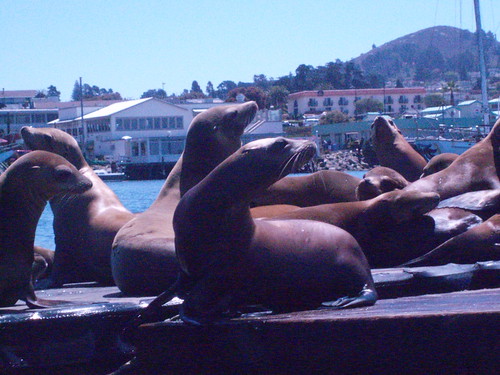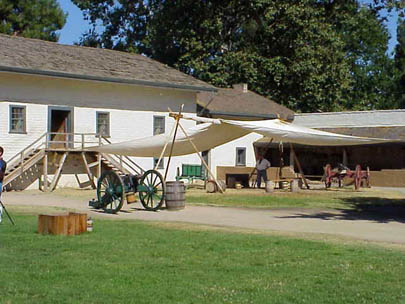 I mentioned a few days ago that I spent a couple nights camping in the state parks over the weekend. I was up in Mendocino and stayed in two different state parks between there and SF. We are really fortunate to have resources like these. They provide a lot to the people of California, not only in terms of recreation and preservation of our natural resources, but also to our economy through the tourist dollars that they bring to their local communities.
I mentioned a few days ago that I spent a couple nights camping in the state parks over the weekend. I was up in Mendocino and stayed in two different state parks between there and SF. We are really fortunate to have resources like these. They provide a lot to the people of California, not only in terms of recreation and preservation of our natural resources, but also to our economy through the tourist dollars that they bring to their local communities.
Yet with the signing of the budget, Arnold Schwarzenegger took another $6 Million from the state parks budget, bringing the total cut from the state parks budget to $14.2 million for this round of cuts. These cuts will result in the closure of nearly 100 parks, or almost a third of the entire state park system. A closure list has yet to be released, but we should be seeing something on that front from the folks at the state park system very shortly.
At any rate, the situation is dire for the state parks. In fact, it is so bad, that the parks’ web page now has google ads on some pages. Scary, but you can’t blame them. Perhaps if enough Californians click through on those Google ads we can save a park or two! But, on a more serious note, the question of how the state parks will be financed is a vexing question.
The trouble is that the parks are seen by some as a sort of luxury. That is far from the case, and many of the really talented and visionary leaders of our state and nation have understood that and advocated for the parks. But as long as they are seen as of lesser importance they will continue to be killed by a thousand cuts. I have no doubt whatsoever that the parks will once again be on the chopping block when we come back to the budget fight, likely around October or so.
Of course, for long-time park defenders, the subject of a ballot measure to protect the funding stream is certain to come up. Parks are always popular, but the polling on the cuts doesn’t exactly bode well. Back in April, Field showed (PDF) that 51% of Californians favor cuts to state parks. Yet, in the press release I’ve included below the fold, there is some vague mention of “a dedicated funding source.” Such an idea would be a mistake for a litany of reasons.
It’s not that I don’t want to protect the parks, it is that our state cannot be run by the ballot box any more. It’s that our system already has too much money outside of the regular budget process. Of course, it is the budget process itself that is the problem. It is no shock that in a system like ours, we cannot fund traditional state priorities. It is a sad, sad sign of the legacy of this generation of leaders.
But, if you have $15 million laying around, perhaps you could shoot it over to the parks. I’m sure they’d appreciate it, and so would I.
California State Parks Foundation Statement on Governor’s Budget Revise
SACRAMENTO, CA – Today, the Governor signed a revised Fiscal Year 2009-2010 state budget, based on the package of bills sent to him by the Legislature on July 24. In using his blue-pencil veto authority, the Governor exacted an additional $6.2 million cut to the state park system, bringing the total General Fund cut to $14.2 million. It is expected (and referenced in the Governor’s budget summary) that more than 100 state parks will be closed. Below is a statement of the California State Parks Foundation (CSPF) on the Governor’s veto.
Statement of Elizabeth Goldstein, CSPF President
“This is a dark day in the history of California’s state park system. At a time when Californians are most in need of their low cost, accessible state parks, the gates are being slammed in their faces. At a time when local businesses, particularly in rural communities, most rely on tourism and park visitation for their own economic stimulus, the doors are being shut to them. In the context of an $85 billion General Fund budget, the $14.2 million in “savings” that would come from closing more than 100 state parks is truly a drop in the bucket. But it’s a small drop that will have a ripple effect, then a tsunami, for park visitors and local economies.
Closing more than one-third of the state park system cannot be done without real consequences to Californians. Although CSPF and other park partners are already trying to identify ways to keep some parks open, it will simply not be possible for the state to walk away from 100 parks and expect others to fully substitute for its public responsibility. California’s state parks have been teetering on the brink of a funding cliff for several decades, this action now pushes them over the edge. California cannot afford for its state parks to be a political football every year. Our state parks desperately need a dedicated funding source to protect them from these now-annual budget actions.”
###
About SOS
The Save Our State Parks (SOS) Campaign is a statewide, grassroots campaign to keep California’s magnificent state parks open. In partnership with organizations, businesses, local governments, and individuals around the state, the California State Parks Foundation is leading SOS Campaign activities and generating awareness and action about budget proposals that would result in unacceptable park closures. For more information visit www.savestateparks.org
About CSPF
With our 100,000 members, the California State Parks Foundation (CSPF) is the only statewide independent nonprofit membership organization dedicated to protecting, enhancing and advocating for California’s magnificent state parks. CSPF is committed to improving the quality of life for all Californians by expanding access to the natural beauty, rich culture and history, and recreational and educational opportunities offered by California’s 279 state parks-the largest state park system in the United States. For more information about California’s state parks, visit www.calparks.org

 The script is simple: Give me oil drilling, or California’s state parks, home to sea lions, die! In non-Hollywood terms, the Governator’s proposed budget will fund California state parks solely through so-far-chimerical offshore oil drilling at Santa Barbara’s Tranquillon Ridge. If the oil drilling project is not approved, then the parks get zero money. “Extortion” may be a harsh word (does “ransom” sound any better?), but Assemblymember Pedro Nava’s
The script is simple: Give me oil drilling, or California’s state parks, home to sea lions, die! In non-Hollywood terms, the Governator’s proposed budget will fund California state parks solely through so-far-chimerical offshore oil drilling at Santa Barbara’s Tranquillon Ridge. If the oil drilling project is not approved, then the parks get zero money. “Extortion” may be a harsh word (does “ransom” sound any better?), but Assemblymember Pedro Nava’s 
 State parks aren’t spotlighted as much as national parks. As Ken Burns noted, would a Wyoming state park get the attention that Yellowstone National Park does? That doesn’t mean that they should be abandoned, or traded for offshore oil drilling. Californians have panned for gold at Columbia State Park, pretend-fired cannons at Sutter’s Fort State Park, meditated on the redwoods of Big Basin State Park, rock climbed Chatsworth State Park, and been enraptured by the Big Sur coastline. (Except for my teen.)
State parks aren’t spotlighted as much as national parks. As Ken Burns noted, would a Wyoming state park get the attention that Yellowstone National Park does? That doesn’t mean that they should be abandoned, or traded for offshore oil drilling. Californians have panned for gold at Columbia State Park, pretend-fired cannons at Sutter’s Fort State Park, meditated on the redwoods of Big Basin State Park, rock climbed Chatsworth State Park, and been enraptured by the Big Sur coastline. (Except for my teen.)

